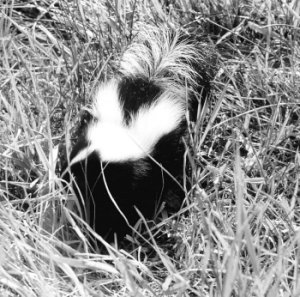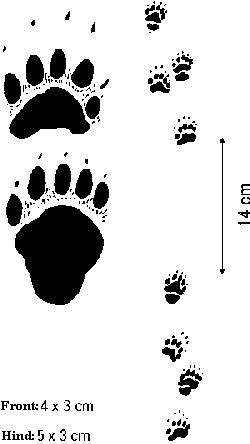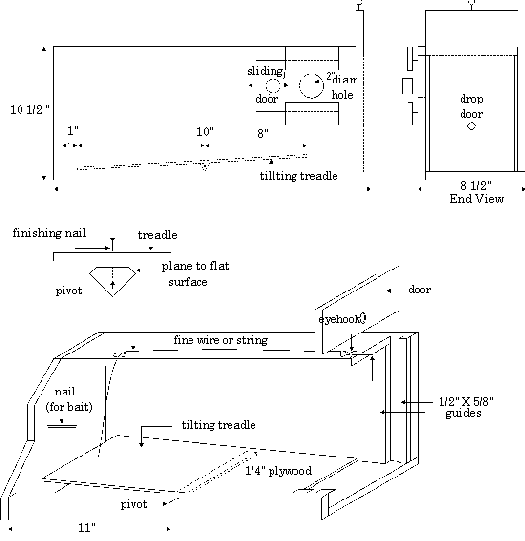| | Identification | Biology, behaviour and reproduction | Legal status | Non-lethal control methods | Repellents | Lethal control methods
People generally relate skunks to the foul-smelling, defensive spray they discharge when scared or threatened. Many people have experienced this unpleasant odor along roadways and on dogs that have come in contact with skunks. Generally, people avoid skunks and have little tolerance for their presence.
In many parts of North America, skunks are the major carriers of rabies. Rabies is a viral disease that affects the nervous system of warm-blooded animals. This disease is normally spread by the bite of a rabies-infected animal and is fatal once symptoms develop. Rabies has been present in the skunk population of southern Alberta, at fluctuating levels, since the late 1970s. Any skunk acting abnormally, such as being tame or active during daylight hours, should be avoided and reported at once to the nearest Agriculture Agri-Food Canada veterinarian.
Identification
The striped skunk, Mephitis mephitis, is the most common of four skunk species found in North America and the only one present in Alberta.
The striped skunk (Figure 1) can be found across the province but is most common in the settled central and southern parts. It is characterized by a black body with a narrow white stripe on the forehead and wider stripes that extend from the neck along each side of the back. Some white may also be present on the top of the black bushy tail. The body size is comparable to a house cat, with most adult skunks measuring about 74 cm long and weighing about 2 to 4 kilograms.
Skunks have sharp claws on the front feet used for digging insects and worms. Their footprint and moving pattern distinguishes them from other similar-sized animals (Figure 2).
Biology, Behaviour and Reproduction
Skunks are members of the weasel family, all of which possess scent glands near the anus. However, the skunk has the most advanced scent gland development..

Figure 1. Striped skunk
The glands contain approximately 15 cc of a yellowish, oily liquid. This fluid is a sulphur compound, n-butyl mercaptan. A skunk can discharge a spray of this fluid as far as 4 to 5 m and spray up to 6 times in succession. It takes up to 10 days to replenish the supply of liquid after full discharge.
Skunks are nocturnal animals, active and feeding during night hours. Their behavior is slow and deliberate, and they appear confident in defending themselves against other animals.
Before a skunk discharges its scent glands, it will usually give a warning by stamping its feet rapidly, raising its tail straight up, clicking its teeth, and growling or hissing. A skunk generally sprays only as a last resort, preferring to retreat from danger.
Skunks eat many harmful insects and rodents but also prey on eggs and young of waterfowl and other ground- nesting birds. They sometimes cause problems in bee yards by feeding on bees as they emerge from the hive. Skunks also occasionally prey on farm poultry and eggs.

Figure 2. Skunk tracks
Several skunks, generally one mature male and several (up to 12) females, gather at and cohabitate a winter den site from fall until spring. The same winter den is generally used year after year if not disturbed. In rural areas, den sites are frequently found under old farm buildings, granaries and other structures. Skunks do not hibernate but generally remain inactive during winter, surviving on their fat stores. However, they may leave the winter den for short periods during warm weather.
Skunks mate during February and March. One male may breed several females. After mating, female skunks disperse from the winter den to a separate maternal den. Grass is usually gathered and brought into the maternal den for bedding.
Generally, 4 to 7 young are born about nine weeks after mating in May or June. The young are blind and deaf at birth with short, fine fur. Adult male skunks do not take part in rearing offspring. The young are nursed in the den for about six weeks before joining their mother on trips outside the den. By this time they are miniature replicas of adults. The young are weaned by about two months of age.
The family group breaks up in the fall, and the young move to new territory. They generally travel about six to 10 km in search of a new home; however, extremes of up to 50 km have been recorded.
Legal Status
Skunks are not protected by law in Alberta. The Agricultural Pests Act declares the skunk a nuisance. This allows landowners to destroy skunks and skunk dens on their land. The Wildlife Act classifies the skunk as a non- licenced animal. Skunks can be hunted or trapped year-round on private land by the property owner and during the fur trapping season by a licensed trapper. Some Alberta Fish and Wildlife Services and municipal Agricultural Service Board offices loan or rent out skunk live traps.
Non-Lethal Control Methods
Exclusion and habitat modification
A skunk becomes a problem when its presence and activities conflict with people. The best way to minimize skunk problems around homes and farmyards is to remove potential sources of food and living sites for skunks.
Skunks can be prevented from living or entering under buildings and other structures by closing all spaces with wood or metal screen. Ensure spaces are enclosed tightly to the ground to discourage digging. When skunks are already living under a building, they can be coerced to leave in the following manner:
- Seal all openings except the main skunk entrance.
- Sprinkle a layer of flour, chalk or other powder outside the entrance.
- After dark, inspect the powder for exiting skunk tracks.
- Once a skunk has left the building, immediately seal the entrance.
- The following evening, re-apply powder, and re-open the entrance to allow any other skunks to leave before permanently closing the opening.
Keep in mind that young skunks will be present from early May until mid-August if a maternal den exists. If possible, buildings should not be skunk-proofed during this period.
If you are unsure how many skunks are present under a building, hang a section of 5 cm or less diameter wire mesh or board overlapping the entrance. Loosely hinge the top with wire. Skunks will push this cover open to leave but should not be able to re-enter. Once you are sure all skunks are out, permanently seal the opening.
Skunks are often very persistent in their attempts to get back into a den from which they have been shut out, especially when young are present. Therefore, wire mesh of 5 cm or less diameter spacing is recommended for blocking entrances. Bury the mesh about 15 cm below ground level to prevent skunks from digging under.
If a skunk enters a garage, cellar, basement or building, leave a door open so it can leave. Do not try to chase it out or spraying may result. Skunks trapped in window wells or other pits can be assisted to leave by carefully lowering a wide board, with cleats nailed on at 15 cm intervals, into the pit. The skunk can then climb up the board and escape. Place wire mesh around or over window wells to keep out skunks.
Skunks can also live beneath brushpiles, rockpiles, stacked lumber and wrecked automobiles. These, as well as old, abandoned or unused granaries and buildings, should be removed to discourage skunk presence. Maintain a clean, uncluttered yard by removing rubbish and cutting tall grass. Road culverts in dry locations are often used by skunks as dens. Place 5 to 7.5 cm diameter wire mesh over culvert openings to prevent use by skunks.
Properly fenced poultry runs will prevent predation by skunks and other wild animals. Do not allow poultry to run loose and also close doors to poultry coops at night.
Place beehives on stands about 1 m high to prevent skunks from eating bees. Beehive locations can be fenced with 50 cm high wire mesh of 7.5 cm or less spacing to prevent skunk access.
Pet food and improperly stored garbage and compost attract skunks and other scavengers. Place garbage and compost in secure containers with tight lids. Do not leave pet food, water dishes and food scraps accessible to skunks.
Repellents
Lights, sounds, and chemicals such as moth balls or ammonia soaked in rags may temporarily discourage skunks from entering an enclosed area. However, other methods are necessary for a permanent solution to the presence of skunks
Lethal Control Methods
Trapping
When skunks need to be removed, trapping with a box- design live trap works the best. These traps should be of solid construction with a single entrance and measure about 18 to 25 cm square and 76 cm long.
When set, the entrance door is locked up in place to allow a skunk to enter the trap. When the skunk steps on a false floor in the trap, the door closes behind the skunk.
Live traps for skunks can be purchased from hardware and other stores, or you can construct a trap from wood (as shown in Figure 3). Some of the commercial live traps are made of open mesh. These should be enclosed with tin or light plywood before use to allow easy handling of captured skunks and reduce the risk of the skunk spraying. Plastic live traps work well, but care must be taken not to let the trapped animals get too hot in sunny warm weather.
Skunks do not generally spray in an enclosed space. An enclosed trap containing a skunk can be gently picked up and moved with a vehicle to another location for skunk release or destruction, generally without incident. Although releasing a skunk back into the environment in a new habitant is not recommended, skunks that are being released should be moved at least 12 km to prevent their return.
Destroy captured skunks humanely. You may release them at a safe location and shoot them with a shotgun or rifle. The Canadian Council on Animal Care (CCAC) guidelines mention the use of gunshot and state that while a shot to the brain produces a quick and humane death, a shot to the heart and lung area may be more appropriate in some situations, and notes considerations for postmortem testing for rabies:
CCAC Guidelines-Gunshot: While a shot to the brain of an animal produces a quick and humane death (Longair et al., 1991), it is best attempted when the animal is immobilized by injury or physical restraint. In free ranging situations, a successful shot to the brain may be difficult to achieve and can result in accidental injury to the animal. Under these conditions, a shot to the heart and lung area may be more appropriate and is recommended in hunter education programs conducted by provincial and territorial agencies. Although death from this shot is not as quick, it is much more certain under free ranging conditions. In some cases, a gunshot to the brain may prevent proper postmortem analysis. This is particularly important if animals are to be tested for rabies.
Humane CCAC guidelines allow skunks to be euthanized in a gassing chamber followed by another method to determine death. Inert gases such as Ar, N2, and CO2 in a gassing chamber are acceptable for euthanization. CCAC guidelines require death to be verified following euthanasia and prior to disposal of the animal.
CCAC guidelines – Euthanasia: An acceptable method of euthanasia renders the animal unconscious and insensitive to pain and other adverse effects; however, there must also be assurance of the subsequent death of the animal. Only when there is assurance that blood is no longer being delivered to the brain, and respiration and reflex activity have ceased, should the animal be considered dead. For some methods of euthanasia (such as CO2 inhalation, stunning using a captive bolt or cervical dislocation), death of the animal should be ensured without it regaining consciousness through application of a second step (e.g., exsanguination, cervical dislocation, decapitation or opening the chest) after application of the primary method of euthanasia. Here is a link to the CCAC guidelines: http://www.ccac.ca/Documents/Standards/Guidelines/Euthanasia.pdf
Skunks are easy to catch in live traps. Use sardines or moist cat food as bait. Place the bait inside, at the back of the trap.
In a situation where cats are likely to get trapped, do not use smelly baits like sardines, but use eggs. Break an egg in front of the trap, and place a whole unbroken egg inside the trap. Any skunk that has gone through the nesting season, that is older than 1 year, will be attracted to eggs.
When the skunk tries to get the bait, the trap door closes and captures the skunk. Make sure you have caught a skunk and not a cat or other small animal before moving the animal or euthanizing it.
Live traps should have an inspection hole in the top for identifying what you have caught. Traps should be inspected every morning and prompt action taken to remove the captured animal.
Foothold and body-gripping traps are not recommended for catching skunks, especially around homes and yards. Skunks often spray when caught in these traps, and unless new, modified traps are used, these older style traps can be inhumane. The older traps can severely injure or kill cats, dogs and other non-target animals.

Figure 3. Box trap
Other Lethal Controls
It is illegal for anyone to use poisons to kill nuisance skunks. But, skunks can sometimes be seen and shot in the early morning or evening.
Prepared by:
Bob Acorn, formerly with Alberta Agriculture, 1996
Revised in 2016 by Phil Merrill
Alberta Agriculture and Forestry
More information, contact:
Alberta Ag-Info Centre
Call toll free: 310-FARM (3276)
Website: www.agriculture.alberta.ca
Source: Agdex 684-5. Revised 2016. |
|